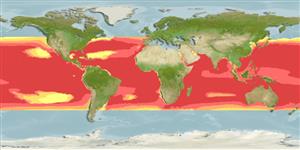Issue
The distinction between Cheilopogon antoncichi and Cheilopogon unicolor awaits clarification.
Environment: milieu / Zona climática / intervalo de profundidade / distribution range
Ecologia
marinhas pelagic-oceanic; oceanódromo (Ref. 51243); intervalo de profundidade 0 - 20 m. Tropical; 46°N - 42°S, 180°E - 180°W
Widespread in tropical zones of all oceans. Western Atlantic: Massachusetts, USA to southern South America (Ref. 7251). Eastern Atlantic: equator eastward to 8°W, Cape Verde. Northwest Atlantic: Canada (Ref. 5951). Indian Ocean: widely distributed but absent from the Red Sea, northern Arabian Sea, and the Persian Gulf (Ref. 3395). Western Pacific: absent in inland waters of southeast Asia (Ref. 9839). Eastern Central Pacific.
Tamanho / Peso / Idade
Maturidade: Lm ? range ? - ? cm
Max length : 35.0 cm TL macho/indeterminado; (Ref. 5217); common length : 25.0 cm TL macho/indeterminado; (Ref. 5217)
Espinhos dorsais (total) : 0; Raios dorsais (total) : 12 - 14; Espinhos anais: 0; Raios anais : 9 - 11. Body dark iridescent blue above, silvery white below; pectorals dark grey, with a broad pale margin crossed by a pale stripe becoming narrower toward anterior fin margin; pelvic fins pale (Ref. 2797). Juveniles up to 10-19 cm SL with dark bars on body and variegated paired fins (Ref. 2797).
Body shape (shape guide): elongated.
Occurs in surface waters of the open ocean (Ref. 30573). Capable of leaping out of the water and gliding for considerable distances above the surface (Ref. 30573). Feeds on zooplankton and small fish (Ref. 9839).
Ciclo de vida ou comportamento de acasalamento
Maturidade | Reprodução | Desova | Ovos | Fecundidade | Larvas
Parin, N.V., 1996. On the species composition of flying fishes (Exocoetidae) in the West-Central part of tropical Pacific. J. Ichthyol. 36(5):357-364. (Ref. 27313)
Status na Lista Vermelha da UICN (Ref. 130435: Version 2025-1)
Ameaça para os humanos
Harmless
Uso pelos humanos
Pescarias: bycatch
Ferramentas
Relatórios especiais
Baixar XML
Fontes da internet
Estimates based on models
Preferred temperature (Ref.
123201): 20.1 - 28.5, mean 26.2 °C (based on 48395 cells).
Índice de diversidade filogenética (Ref.
82804): PD
50 = 0.5000 [Uniqueness, from 0.5 = low to 2.0 = high].
Bayesian length-weight: a=0.00631 (0.00288 - 0.01384), b=3.05 (2.85 - 3.25), in cm total length, based on LWR estimates for this (Sub)family-body shape (Ref.
93245).
Nível Trófico (Ref.
69278): 4.0 ±0.65 se; based on food items.
Resiliência (Ref.
120179): Elevada, tempo mínimo de duplicação da população menor que 15 meses (Preliminary K or Fecundity.).
Fishing Vulnerability (Ref.
59153): Low vulnerability (25 of 100).
🛈
